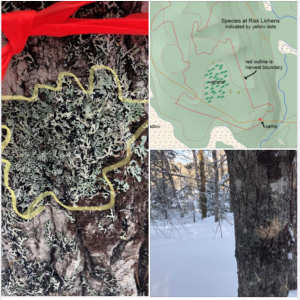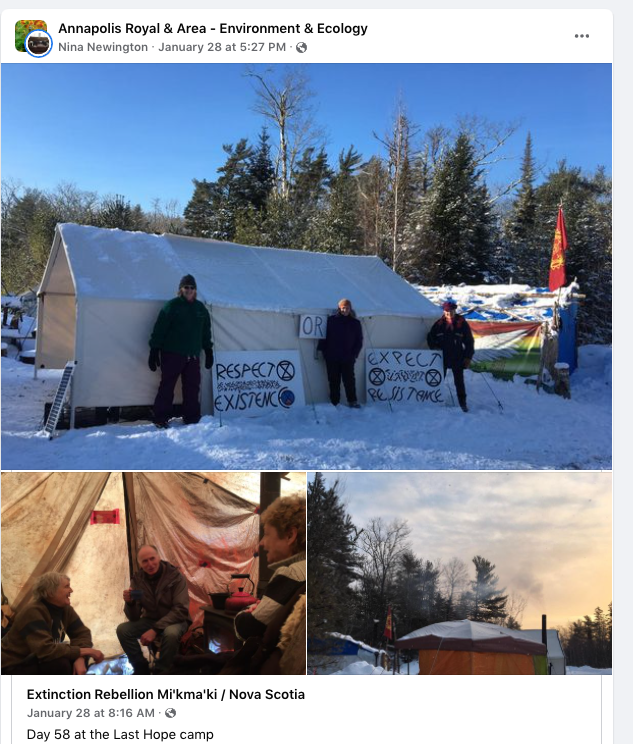From Extinction Rebellion Mi’kma’ki / Nova Scotia (Public Facebook Page) Jan 26, 2022: (bolding inserted)
“Day 56 at the Last Hope camp
 Good news: a temporary halt has been put on the plan to cut the forest we are protecting because some rare lichens have been identified here. This does not mean the forest is now protected and we can go home. Far from it. But it is a step in the right direction.
Good news: a temporary halt has been put on the plan to cut the forest we are protecting because some rare lichens have been identified here. This does not mean the forest is now protected and we can go home. Far from it. But it is a step in the right direction.
“As people have learned about this forest so many people are passionate to protect, lichen enthusiasts have expressed an interest in coming to see for themselves. One did so twice last week. In spite of deep snow, he found three kinds of rare and sensitive lichens growing on oak and maple near the swamps. They are each listed as Species At Risk and require ‘Special Management Practices’ meaning, in this case, no cutting within 100m of each of these kinds of lichen.
“He reported his finds to the Department of Natural Resources and was agreeably surprised when they got right back to him and said they are putting a pause on the plan to cut until an expert they choose can come out and confirm these findings. They are also going to survey the rest of the parcel for rare lichens. Once they have done that, DNRR could allow the cut to go ahead, just requiring the contractor to stay 100m away from each listed lichen.
“With luck DNRR’s expert will find enough rare lichens in enough spots that the government will realise that this forest really should be protected. Failing that, perhaps their finds will make it unfeasible to harvest this forest. But we won’t know that until after the survey, and we don’t know when that will happen.
“So this is good news but it does not mean we will let our guard down. We are as committed as ever to protecting this forest and that means no cutting here. So we will keep the camp going but we can relax a little until the survey has been done.
In case you are wondering, DNRR will draw their expert from a very short list of lichenologists, all of them well-respected. So we are not concerned about that aspect.
“We are concerned by how little care our government takes of Crown lands which are the unceded, unsurrendered ancestral lands of the Mi’kmaw people. We know that cutting would already have started in this forest and the lichens’ habitat would have been destroyed if we weren’t camped out here.
“Did DNRR’s biologists ever actually come out and visit this site? Or did they ‘look’ at it from their desks? In We now know this forest contains a lichen called Frosted Glass Whisker Lichen that only grows in mature or old growth hardwood forest. It is extremely picky about its habitat and extremely vulnerable to disturbance. How many rare and precious life forms are being destroyed while government after government allows the decimation of our forests? We cannot afford this carelessness any more. We must save what we can, while we can.
“Here are some specifics about the lichens that were found. All are classified as Species At Risk:
“Common name: Wrinkled Shingle Lichen
Scientific name: Pannaria lurida
Known from 56 occurrences in Canada of which 49 in NS. Rate of decline 32% since 1986. A primary threat is harvesting of hardwood forest.
“Common name: Frosted Glass-whiskers (NS pop’n)
Scientific name: Sclerophora peronella
Tiny stubble lichen that is difficult to locate; Restricted to mature or old- growth hardwood forest; Is very habitat specific, associated with very old forest. Habitat conditions for its occurrence are very rare on the landscape. Like other stubble lichens , it likely takes a long time to develop and once disturbed will take a very long time to re-establish.
“Common name: Black-foam Lichen
Scientific name: Anzia colpodes
Known from ON, PQ, NB and NS; NS population appears to be only remaining occurrences; Lichen is widespread, but uncommon; Deforestation is main threat. Declining in northeast US, research indicates it may be associated with old growth forests.”
———–
For some background, view Current Issues/AP068499 Beals Meadow
The ‘story at AP068499 Beals Meadow is beginning to sound like that of the Corbett Lake Old Hardwood Forest, not very far away. A group of citizens/Extinction Rebellion Mi’kma’ki / Nova Scotia blocks a proposed harvest and closer investigation reveals species-at-risk and many other qualities overlooked by the government department charged with managing our public lands.
——-
Some additional comments, from – Rare lichen discovery puts Annapolis County forest harvest plan on hold
Francis Campbell on saltwire.com, Jan 27, 2022
Newington said it’s a “remarkable find,” to locate the three lichen, especially the frosted glass whisker lichen.
“It’s a very rare lichen that grows only on very old trees, generally,” Newington said. “You don’t find a whole bunch of them in one place.” They are tiny and hard to spot. “You have to peer into the rotting crack of the red maple and let your eyes adjust to see the little pink heads and stems,” Newington said. Newington was told that by a lichen enthusiast who a week ago came to visit the
forest near the Last Hope camp
Natural Resources Department Spokesman Steven Stewart said in an email Wednesday that the department was alerted to several potential occurrences of a rare lichen and placed a temporary hold on the harvest plan Friday…Buffer zones will be applied to any confirmed occurrences of lichen before the temporary hold is lifted, he said. The buffer zone would be 100 metres…
Newington, who has been involved in forestry protests before, particularly in Digby County more than a year ago, said the lichen discovery throws into question past harvest approvals by the provincial department, approvals that were to have included careful planning, reviews and monitoring.
“The thing that you think about is that they (natural resources) are not coming out and looking at these harvest parcels before they approve the harvests,” Newington said.
“Here’s this forest that local people told us was of high ecological value and we believe them because they’ve been here for 60 years cruising through this land and they know what they are talking about. But DNR doesn’t talk to local people to find out the value of the forest they are going to cut down, they don’t tell anyone what they are up to.”
Newington said people who live nearby would have to search on a harvest plan map to notice that, “gosh, this is a forest that I’ve loved for 60 years and stopped Bowater from cutting 20 years ago.” “What kind of process is that,” she said.
And why is the government in such a hurry to delineate the rare lichens?

Post on Jan 28, 2022
Day 58 at the Last Hope camp
A still night, stars sharp in the dark sky, -25C at dawn on Thursday, the start of our ninth week here. Then sun all day. We were grateful for two more donations of wood including some very dry hardwood, at a time of year when anyone who relies on wood for heat, whether in a house or a tent, is likely to be eyeing their pile, wondering what February will bring.
The discovery of rare lichens in the forest we are protecting has brought more media attention. The Department of Natural Resources and Renewables seems to be in a hurry to get on with the promised survey of lichens in the rest of the parcel: they told the Chronicle Herald’s reporter Francis Campbell that it will be done in the next week. Not that we are against the government keeping its promises, far from it, but this promptness seems surprising given that there are a couple of feet of snow on the ground and another foot in the forecast for this weekend. These are not, we have been told by an experienced lichen hunter, ideal conditions.
One of the lichens, Anzia colpodes, the Black-foam lichen, grows conveniently at eye-level from the ground, but the other two can occur much lower down the trunk.
This is not to cast doubt at all on the lichenologist tasked with doing the survey but we do wonder why DNRR is suddenly in such a rush. They have put a hold on the proposed cut so the forest isn’t going anywhere.
Nor are we. After eight weeks, our resolve is strong and our support is growing. Three snowmobilers stopped off to thank us for what we are doing yesterday afternoon. And the flag of the seven traditional districts of Mi’kma’ki, a gift from the District Chief of this area, Kespukwitk, flies over our camp to remind us all that this land we are defending is the unceded, unsurrendered territory of the Mi’kmaw people.
